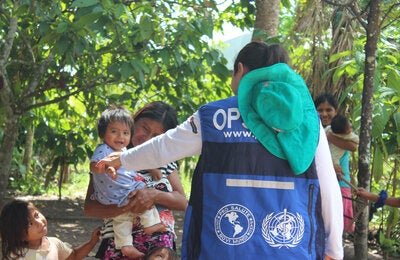
Washington D.C. 26 September 2024 (PAHO) – A new report on cervical cancer in the region of the Americas launched today by the Pan American Health Organization (PAHO) urges countries to implement new innovations in cervical cancer prevention, testing and treatment, to help close gaps and get on track to achieve the elimination goals by 2030.
Cervical cancer is the fourth most common cancer in women worldwide, currently affecting over 78,000 women, and causing 40,000 deaths each year in the Americas. Cervical cancer continues to disproportionately impact women in low and middle-income countries. The Latin America and the Caribbean region accounts for 80% of all cases in the Americas and 84% of deaths, making it the region with the second-highest rates of cervical cancer cases and deaths in the world (after Africa).
The primary cause of cervical cancer is persistent infection with high-risk types of human papillomaviruses (HPV). Cervical cancer can be prevented through vaccination against HPV in adolescents, screening and treating women with precancerous lesions.
In 2020, member states of the World Health Organization (WHO) adopted the Strategy to Accelerate the Elimination of Cervical Cancer as a Public Health Problem. The strategy outlines three objectives for 2030: 90% HPV vaccination coverage in girls by the age of 15, 70% screening coverage of women with high-performance tests by the ages of 35 and 45 years, and 90% treatment of precancerous lesions and management of invasive cancer cases (known as the 90-70-90 targets).
According to the new report which reviews countries’ progress towards this strategy, while 32 of 35 countries of the Americas have introduced the HPV vaccine into their national immunization schedules, coverage varies widely from less than 10% to over 80%.
This is due to a range of factors including an overall reduction in childhood vaccination rates during the COVID-19 pandemic, vaccine hesitancy, the high cost of HPV vaccines, as well as a lack of access to vaccine services, particularly in remote areas, and insufficient vaccinations at school.
To tackle this, PAHO recommends the implementation of strategies to increase coverage, such as switching to a one-dose schedule, which 21 of 35 countries now have, as well as to implement communications campaigns to raise awareness and address misinformation around the HPV vaccine. Countries should also strengthen vaccine delivery strategies, ensuring outreach efforts for those in hard-to-reach areas, and working alongside ministries of education to encourage vaccination at school with at least one dose of HPV vaccine by age 15.
To prevent cervical cancer or detect it earlier, the report also highlights the importance of screening women and transitioning from the traditional use of cytology tests to the HPV test, along with adequate management of women with abnormal findings. Currently, just 6 countries report using the HPV test as the primary screening test, but the degree of implementation and coverage is variable.
The HPV test has an added benefit that enables women to self-sample via vaginal swab, eliminating both the cultural and access barriers that prevent many women from getting screened.
“While increasing HPV vaccination coverage is key to eliminate cervical cancer, countries of the Americas must also urgently step-up efforts to shift from conventional PAP to HPV testing, and improve cancer treatment” Dr. Anselm Hennis, Director of Noncommunicable Diseases and Mental Health at PAHO said.
The Pan American Health Organization is actively supporting countries in the region to strengthen their national plans for the elimination of cervical cancer, based on HPV vaccination, testing for HPV and treating women with precancerous lesions and cancer. Similarly, PAHO is offering technical support to improve information systems to monitor and evaluate actions and progress towards the elimination of cervical cancer as a public health problem.
Elimination initiative
Cervical cancer is one of the diseases addressed in PAHO’s Elimination Initiative, which aims to eliminate more than 30 communicable diseases and related conditions by 2030.



